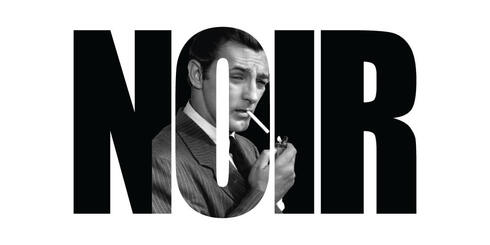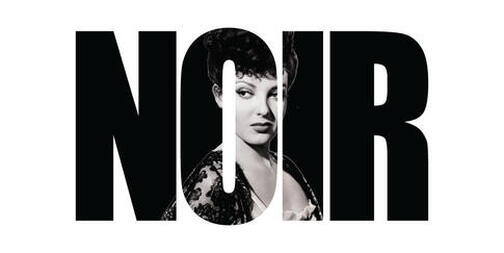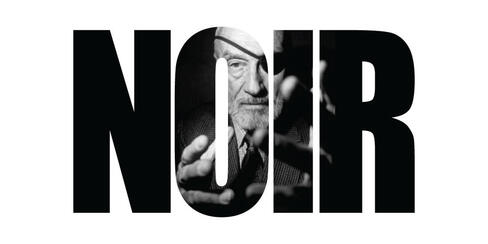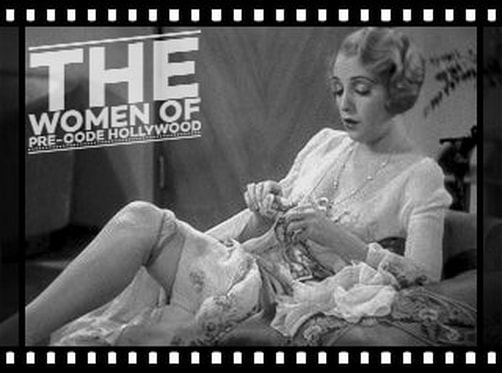BARBARA STANWYCK
AND FILM NOIR
Barbara Stanwyck had a significant impact on the film noir genre through her powerful performances and her ability to embody complex and captivating characters. She became one of the quintessential actresses associated with the genre, and her contributions helped shape the portrayal of women in film noir.
Stanwyck's performances in film noir showcased her versatility as an actress and her ability to portray morally ambiguous and strong-willed female characters. She often played femme fatales, embodying the archetype of the seductive and manipulative woman who leads men down a dark path. Her performances were marked by a combination of vulnerability, intelligence, and a sense of determination that made her characters compelling and memorable.
One of Stanwyck's most iconic film noir roles was in "Double Indemnity" (1944), directed by Billy Wilder. In this film, she portrayed Phyllis Dietrichson, a calculating and alluring woman who conspires with an insurance salesman to murder her husband. Stanwyck's portrayal of Phyllis was layered and nuanced, blending sensuality with a sense of danger and desperation. Her performance in "Double Indemnity" is often cited as one of the definitive examples of the femme fatale archetype.
Another notable film noir role for Stanwyck was in "The Strange Love of Martha Ivers" (1946), where she played Martha Ivers, a woman with a dark secret from her past. The film explored themes of manipulation, guilt, and the destructive nature of ambition, and Stanwyck's performance added depth and complexity to the character.
Stanwyck's impact on film noir extended beyond her individual performances. Her presence and influence helped shape the portrayal of women in the genre. She brought a sense of agency and power to her characters, challenging traditional gender roles and expectations. Stanwyck's performances in film noir paved the way for future actresses to explore complex and multifaceted female characters in the genre. Overall, Barbara Stanwyck's impact on film noir can be seen through her captivating performances, her portrayal of strong and enigmatic women, and her contribution to the evolution of the femme fatale archetype. She remains a defining figure in the genre and her work continues to be celebrated as a testament to her talent and influence.
Stanwyck's performances in film noir showcased her versatility as an actress and her ability to portray morally ambiguous and strong-willed female characters. She often played femme fatales, embodying the archetype of the seductive and manipulative woman who leads men down a dark path. Her performances were marked by a combination of vulnerability, intelligence, and a sense of determination that made her characters compelling and memorable.
One of Stanwyck's most iconic film noir roles was in "Double Indemnity" (1944), directed by Billy Wilder. In this film, she portrayed Phyllis Dietrichson, a calculating and alluring woman who conspires with an insurance salesman to murder her husband. Stanwyck's portrayal of Phyllis was layered and nuanced, blending sensuality with a sense of danger and desperation. Her performance in "Double Indemnity" is often cited as one of the definitive examples of the femme fatale archetype.
Another notable film noir role for Stanwyck was in "The Strange Love of Martha Ivers" (1946), where she played Martha Ivers, a woman with a dark secret from her past. The film explored themes of manipulation, guilt, and the destructive nature of ambition, and Stanwyck's performance added depth and complexity to the character.
Stanwyck's impact on film noir extended beyond her individual performances. Her presence and influence helped shape the portrayal of women in the genre. She brought a sense of agency and power to her characters, challenging traditional gender roles and expectations. Stanwyck's performances in film noir paved the way for future actresses to explore complex and multifaceted female characters in the genre. Overall, Barbara Stanwyck's impact on film noir can be seen through her captivating performances, her portrayal of strong and enigmatic women, and her contribution to the evolution of the femme fatale archetype. She remains a defining figure in the genre and her work continues to be celebrated as a testament to her talent and influence.
AVAILABLE FILMS:
BABY FACE (1933)
BALL OF FIRE (1941)
BANJO ON MY KNEE (1936)
BITTER TEA OF GENERAL YEN, THE (1933)
BREAKFAST FOR TWO (1937)
CHRISTMAS IN CONNECTICUT (1945)
CLASH BY NIGHT (1952)
CRIME OF PASSION (1957)
CRY WOLF (1947)
DOUBLE INDEMNITY (1944)
EAST SIDE, WEST SIDE (1949)
ESCAPE TO BURMA (1955)
FILE ON THELMA JORDAN, THE (1950)
FORBIDDEN (1932)
FORTY GUNS (1957)
GAMBLING LADY (1934)
GOLDENBOY (1939)
HIS BROTHER'S WIFE (1936)
HOLLYWOOD CANTEEN (1944)
ILLICIT (1931)
JEOPARDY (1953)
LADIES THEY TALK ABOUT (1933)
LADY EVE, THE (1941)
LADY OF BURLESQUE (1943)
LOCKED DOOR, THE (1929)
LOST LADY, A (1934)
MAD MISS MANTON, THE (1938)
MAN WITH A CLOAK, THE (1951)
MEET JOHN DOE (1941)
MIRACLE WOMAN, THE (1931)
NIGHT NURSE (1931)
NO MAN OF HER OWN (1950)
OTHER LOVE, THE (1947)
PLOUGH AND THE STARS, THE (1936)
PURCHASE PRICE, THE (1932)
REMEMBER THE NIGHT (1940)
SECRET BRIDE, THE (1934)
SHOPWORN (1932)
SORRY, WRONG NUMBER (1948)
STELLA DALLAS (1937)
LAUREL & HARDY SHORTS: OLIVER THE EIGHTH, THE STOLEN JOOLS, COUNTY HOSPITAL (0)
STRANGE LOVE OF MARTHA IVERS, THE (1946)
TEN CENTS A DANCE (1931)
THIS IS MY AFFAIR (1937)
TWO MRS. CARROLS, THE (1947)
UNION PACIFIC (1939)
WITNESS TO MURDER (1954)
WOMAN IN RED, THE (1935)
BALL OF FIRE (1941)
BANJO ON MY KNEE (1936)
BITTER TEA OF GENERAL YEN, THE (1933)
BREAKFAST FOR TWO (1937)
CHRISTMAS IN CONNECTICUT (1945)
CLASH BY NIGHT (1952)
CRIME OF PASSION (1957)
CRY WOLF (1947)
DOUBLE INDEMNITY (1944)
EAST SIDE, WEST SIDE (1949)
ESCAPE TO BURMA (1955)
FILE ON THELMA JORDAN, THE (1950)
FORBIDDEN (1932)
FORTY GUNS (1957)
GAMBLING LADY (1934)
GOLDENBOY (1939)
HIS BROTHER'S WIFE (1936)
HOLLYWOOD CANTEEN (1944)
ILLICIT (1931)
JEOPARDY (1953)
LADIES THEY TALK ABOUT (1933)
LADY EVE, THE (1941)
LADY OF BURLESQUE (1943)
LOCKED DOOR, THE (1929)
LOST LADY, A (1934)
MAD MISS MANTON, THE (1938)
MAN WITH A CLOAK, THE (1951)
MEET JOHN DOE (1941)
MIRACLE WOMAN, THE (1931)
NIGHT NURSE (1931)
NO MAN OF HER OWN (1950)
OTHER LOVE, THE (1947)
PLOUGH AND THE STARS, THE (1936)
PURCHASE PRICE, THE (1932)
REMEMBER THE NIGHT (1940)
SECRET BRIDE, THE (1934)
SHOPWORN (1932)
SORRY, WRONG NUMBER (1948)
STELLA DALLAS (1937)
LAUREL & HARDY SHORTS: OLIVER THE EIGHTH, THE STOLEN JOOLS, COUNTY HOSPITAL (0)
STRANGE LOVE OF MARTHA IVERS, THE (1946)
TEN CENTS A DANCE (1931)
THIS IS MY AFFAIR (1937)
TWO MRS. CARROLS, THE (1947)
UNION PACIFIC (1939)
WITNESS TO MURDER (1954)
WOMAN IN RED, THE (1935)
VIDEO TRIBUTE:
Barbara Stanwyck
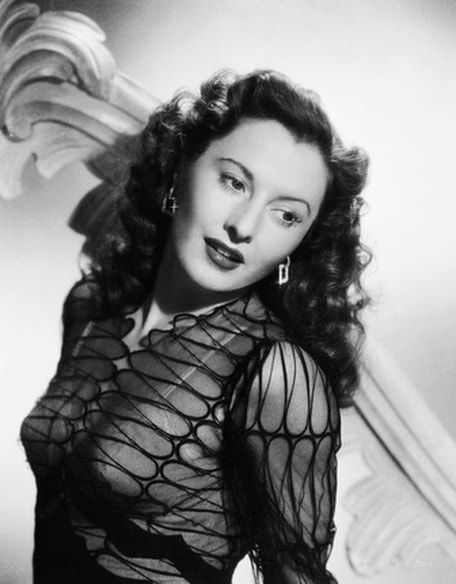
Barbara Stanwyck was an American actress born on July 16, 1907, in Brooklyn, New York. She is widely regarded as one of the greatest actresses of the Golden Age of Hollywood and made significant contributions to film, television, and stage throughout her career.
Stanwyck's early life was marked by tragedy as she lost both her parents at a young age. She began her career as a performer in various entertainment venues, including dancing and chorus line work. She eventually transitioned to acting and made her Broadway debut in 1926.
In 1929, Stanwyck moved to Hollywood and signed a contract with Columbia Pictures. She quickly established herself as a versatile actress, starring in a wide range of genres, including drama, comedy, and film noir. Stanwyck's breakthrough came with her role in the pre-Code film "Baby Face" (1933), where she played a young woman who uses her sexuality to climb the social ladder. The film showcased her talent and versatility as an actress, and she continued to deliver strong performances throughout the 1930s.
During the 1940s, Stanwyck became associated with the film noir genre and delivered some of her most memorable performances in films like "Double Indemnity" (1944), directed by Billy Wilder, where she portrayed a seductive and morally ambiguous femme fatale. Her performance in the film earned her critical acclaim and established her as a prominent figure in the noir genre.
Stanwyck's career extended beyond film, and she successfully transitioned to television in the 1950s. She starred in the popular series "The Barbara Stanwyck Show" (1960-1961) and later achieved further success with the western series "The Big Valley" (1965-1969), for which she received an Emmy Award nomination. Her work in television solidified her status as a versatile and respected actress across different mediums.
Throughout her career, Stanwyck received numerous accolades, including four Academy Award nominations for Best Actress. She was known for her ability to bring depth and complexity to her characters, whether playing strong and independent women, vulnerable heroines, or morally ambiguous figures.
Barbara Stanwyck's contributions to the world of cinema and entertainment spanned several decades. She left a lasting impact on the industry, not only through her impressive body of work but also through her professionalism, versatility, and ability to command the screen. She remains an iconic figure in the history of American film and a revered actress whose legacy continues to inspire generations of performers. Barbara Stanwyck passed away on January 20, 1990, at the age of 82.
Stanwyck's early life was marked by tragedy as she lost both her parents at a young age. She began her career as a performer in various entertainment venues, including dancing and chorus line work. She eventually transitioned to acting and made her Broadway debut in 1926.
In 1929, Stanwyck moved to Hollywood and signed a contract with Columbia Pictures. She quickly established herself as a versatile actress, starring in a wide range of genres, including drama, comedy, and film noir. Stanwyck's breakthrough came with her role in the pre-Code film "Baby Face" (1933), where she played a young woman who uses her sexuality to climb the social ladder. The film showcased her talent and versatility as an actress, and she continued to deliver strong performances throughout the 1930s.
During the 1940s, Stanwyck became associated with the film noir genre and delivered some of her most memorable performances in films like "Double Indemnity" (1944), directed by Billy Wilder, where she portrayed a seductive and morally ambiguous femme fatale. Her performance in the film earned her critical acclaim and established her as a prominent figure in the noir genre.
Stanwyck's career extended beyond film, and she successfully transitioned to television in the 1950s. She starred in the popular series "The Barbara Stanwyck Show" (1960-1961) and later achieved further success with the western series "The Big Valley" (1965-1969), for which she received an Emmy Award nomination. Her work in television solidified her status as a versatile and respected actress across different mediums.
Throughout her career, Stanwyck received numerous accolades, including four Academy Award nominations for Best Actress. She was known for her ability to bring depth and complexity to her characters, whether playing strong and independent women, vulnerable heroines, or morally ambiguous figures.
Barbara Stanwyck's contributions to the world of cinema and entertainment spanned several decades. She left a lasting impact on the industry, not only through her impressive body of work but also through her professionalism, versatility, and ability to command the screen. She remains an iconic figure in the history of American film and a revered actress whose legacy continues to inspire generations of performers. Barbara Stanwyck passed away on January 20, 1990, at the age of 82.
quotes:
"I'm a tough old broad from Brooklyn. I intend to go on acting until I'm ninety and they won't need to paste my face with make-up."
[referring to director Frank Capra] "Eyes are the greatest tool in film. Mr. Capra taught me that. Sure, it's nice to say very good dialogue, if you can get it. But great movie acting - watch the eyes!"
[in 1939 on the fact that her fiancé, Robert Taylor, was four years younger than she] "The boy's got a lot to learn and I've got a lot to teach."
"My only problem is finding a way to play my fortieth fallen female in a different way from my thirty-ninth."
- Barbara Stanwyck
Trivia:
Her stage name was inspired by a theatrical poster that read "Jane Stanwyck in 'Barbara Frietchie.'". | In 1944, when she earned $400,000, the government listed her as the nation's highest-paid woman.
Often called "The Best Actress Who Never Won an Oscar."
Her role as Phyllis Dietrichson in Double Indemnity (1944) was ranked #8 on the American Film Institute's "100 Greatest Screen Heroes and Villains" list. The performance also was ranked #98 on Premiere Magazine's 100 Greatest Performances of All Time list (2006) and #58 on Premiere Magazine's 100 Greatest Movie Characters of All Time list.
Her stormy 7 year marriage to Frank Fay finally ended after a drunken brawl, during which he tossed their adopted son, Dion, into the swimming pool. Their divorce was finalized on December 30, 1935. The couple had adopted Dion on December 5, 1932. Dion (born John Charles Greene, February 5, 1932, Los Angeles County, California - died May 17, 2006, Van Nuys, Los Angeles County, California) became permanently estranged from Stanwyck in February 1951, when he was 19 years old; the rift never healed. | Picked up the starring role in Ball of Fire (1941) after Ginger Rogers dropped out.
On October 27, 1981, Stanwyck was awakened by a burglar at 1:00 in the morning. She was hit on the head with an unknown object then forced into a closet while the intruder ransacked the house and got away with $5,000 worth of jewels. She was treated for minor head wounds at Cedars-Sinai Medical Center and released the next day. Four years later, in 1985, the house was destroyed in a fire. She expressed upset at losing personal keepsakes, including love letters from Robert Taylor.
She was replaced by Susan Hayward in Heat of Anger (1972), which was to have been a pilot for a prospective TV series to be called "Fitzgerald and Pride.".
A Star Is Born (1937) starring Janet Gaynor and Fredric March is said to be modeled after Stanwyck's rise to stardom and first husband Frank Fay's descent into obscurity.
William Holden was considered to be too lightweight for the lead role in Golden Boy (1939), but Stanwyck urged producers to keep him in the picture and it was through her efforts he was kept in the picture, and the role made him a star. In 1978, at the The 50th Annual Academy Awards (1978), before starting the presentation of the sound award, Holden publicly thanked her for what she did. She nearly broke down in tears and kissed Holden, and the exchange received thunderous audience applause.
Planned to play the lead in Mildred Pierce (1945), but Joan Crawford was faster and got the role. | Throughout her career she was known for her kindness and patience with younger performers. Marilyn Monroe, who worked with Stanwyck in the 1952 film Clash by Night (1952) said that Stanwyck was the only member of Hollywood's older generation who was kind to her.
When she was awarded an Honorary Oscar for lifetime achievement, the statuette was presented to her by John Travolta who later confessed that the experience was his supreme Oscar moment. Stanwyck had been a Travolta family favorite for years. [1982]
She twice played a character named Jessica Drummond in two completely different movies: My Reputation (1946) and Forty Guns (1957).
Lived near Joan Crawford during her marriage to Frank Fay. According to Christina Crawford, between 1932 and 1934, Stanwyck would escape from the alcoholic and volatile Fay when things got too hot by scaling a fence on their property. She would stay with Crawford, who lived across the street, until the heat died down. Stanwyck and Crawford had been friends since the days when they were single young actresses and remained friends until Crawford's death.
Was considered for the role of Scarlett O'Hara in Gone with the Wind (1939).
In a first season episode of The Big Valley (1965) (called "Tunnel of Gold"), Stanwyck's character, Victoria Barkley, explained that she lost both of her parents as a young child, and was raised in a foster home. Years later, Stanwyck explained it written that way because the exact same thing had happened to her as a child.
Three comedies that she starred-in in 1941: Meet John Doe (1941), Ball of Fire (1941) and The Lady Eve (1941) were Oscar nominated for Best Story, but none of them won the award. | She appeared in four films that have been selected for the National Film Registry by the Library of Congress as being "culturally, historically or aesthetically" significant: Baby Face (1933), The Lady Eve (1941), Ball of Fire (1941) and Double Indemnity (1944).
In his autobiography, Cecil B. DeMille wrote that, among the actresses he directed, Barbara Stanwyck was his favorite. He said, "Barbara's name is the first that comes to mind, as one on whom a director can always count to do her work with all her heart.".
Often called "The Best Actress Who Never Won an Oscar."
Her role as Phyllis Dietrichson in Double Indemnity (1944) was ranked #8 on the American Film Institute's "100 Greatest Screen Heroes and Villains" list. The performance also was ranked #98 on Premiere Magazine's 100 Greatest Performances of All Time list (2006) and #58 on Premiere Magazine's 100 Greatest Movie Characters of All Time list.
Her stormy 7 year marriage to Frank Fay finally ended after a drunken brawl, during which he tossed their adopted son, Dion, into the swimming pool. Their divorce was finalized on December 30, 1935. The couple had adopted Dion on December 5, 1932. Dion (born John Charles Greene, February 5, 1932, Los Angeles County, California - died May 17, 2006, Van Nuys, Los Angeles County, California) became permanently estranged from Stanwyck in February 1951, when he was 19 years old; the rift never healed. | Picked up the starring role in Ball of Fire (1941) after Ginger Rogers dropped out.
On October 27, 1981, Stanwyck was awakened by a burglar at 1:00 in the morning. She was hit on the head with an unknown object then forced into a closet while the intruder ransacked the house and got away with $5,000 worth of jewels. She was treated for minor head wounds at Cedars-Sinai Medical Center and released the next day. Four years later, in 1985, the house was destroyed in a fire. She expressed upset at losing personal keepsakes, including love letters from Robert Taylor.
She was replaced by Susan Hayward in Heat of Anger (1972), which was to have been a pilot for a prospective TV series to be called "Fitzgerald and Pride.".
A Star Is Born (1937) starring Janet Gaynor and Fredric March is said to be modeled after Stanwyck's rise to stardom and first husband Frank Fay's descent into obscurity.
William Holden was considered to be too lightweight for the lead role in Golden Boy (1939), but Stanwyck urged producers to keep him in the picture and it was through her efforts he was kept in the picture, and the role made him a star. In 1978, at the The 50th Annual Academy Awards (1978), before starting the presentation of the sound award, Holden publicly thanked her for what she did. She nearly broke down in tears and kissed Holden, and the exchange received thunderous audience applause.
Planned to play the lead in Mildred Pierce (1945), but Joan Crawford was faster and got the role. | Throughout her career she was known for her kindness and patience with younger performers. Marilyn Monroe, who worked with Stanwyck in the 1952 film Clash by Night (1952) said that Stanwyck was the only member of Hollywood's older generation who was kind to her.
When she was awarded an Honorary Oscar for lifetime achievement, the statuette was presented to her by John Travolta who later confessed that the experience was his supreme Oscar moment. Stanwyck had been a Travolta family favorite for years. [1982]
She twice played a character named Jessica Drummond in two completely different movies: My Reputation (1946) and Forty Guns (1957).
Lived near Joan Crawford during her marriage to Frank Fay. According to Christina Crawford, between 1932 and 1934, Stanwyck would escape from the alcoholic and volatile Fay when things got too hot by scaling a fence on their property. She would stay with Crawford, who lived across the street, until the heat died down. Stanwyck and Crawford had been friends since the days when they were single young actresses and remained friends until Crawford's death.
Was considered for the role of Scarlett O'Hara in Gone with the Wind (1939).
In a first season episode of The Big Valley (1965) (called "Tunnel of Gold"), Stanwyck's character, Victoria Barkley, explained that she lost both of her parents as a young child, and was raised in a foster home. Years later, Stanwyck explained it written that way because the exact same thing had happened to her as a child.
Three comedies that she starred-in in 1941: Meet John Doe (1941), Ball of Fire (1941) and The Lady Eve (1941) were Oscar nominated for Best Story, but none of them won the award. | She appeared in four films that have been selected for the National Film Registry by the Library of Congress as being "culturally, historically or aesthetically" significant: Baby Face (1933), The Lady Eve (1941), Ball of Fire (1941) and Double Indemnity (1944).
In his autobiography, Cecil B. DeMille wrote that, among the actresses he directed, Barbara Stanwyck was his favorite. He said, "Barbara's name is the first that comes to mind, as one on whom a director can always count to do her work with all her heart.".

